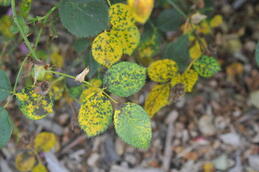
The fungus can survive on fallen leaves or canes and is disseminated primarily by splashing water. Cultural practices are the first line of defense.
1. Don't plant susceptible roses unless you are willing to use fungicide sprays. Purdue University has a list of blackspot resistant cultivars.
2. Keep irrigation water off the foliage. Drip irrigation works well with roses.
3. Plant roses in sun in areas with good air movement to limit the amount of time the
foliage is wet.
4. Remove diseased leaves that have fallen and prune out infected rose canes to minimize inoculum.
If needed, protect foliage with a regular spray program (10- to 14-day schedule) of effective fungicides. Recommended fungicides include tebuconazole (BioAdvanced Disease Control for Roses, Flowers and Shrubs, BioAdvanced All-In-One Rose & Flower Care), myclobutanil (Immunox, F-Stop Lawn & Garden Fungicide) and chlorothalonil (Broad Spectrum Lawn & Garden Fungicide, Garden Disease Control, others). (Ward Upham)
 RSS Feed
RSS Feed
